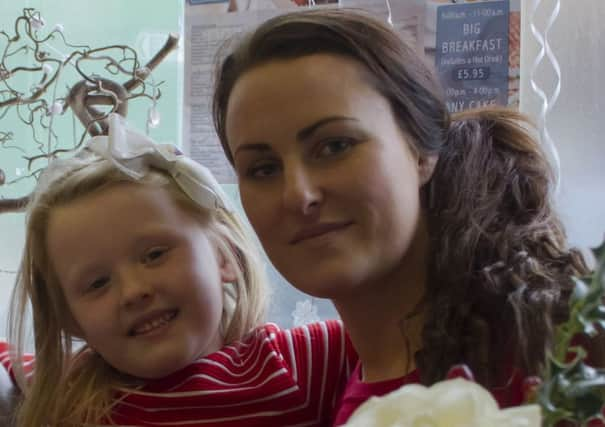Sunderland mum to have healthy breasts removed over Angelina Jolie cancer gene fears


Laura Warren, 32, has made the agonising decision to undergo a double mastectomy after a new genetic test revealed she has a high chance of developing breast cancer.
Though she has no symptoms of the disease, the Pennywell mum has chosen to have the preventative measure of surgery to try and ensure she has a future with her children Lola, six, and Blake, three.
Advertisement
Hide AdAdvertisement
Hide AdWomen who carry the faulty BRAC1 & 2 genes have a 60-90% chance of developing breast cancer, and Laura says high-profile cases such as Angelina Jolie, who chose to have a preventative mastectomy in 2013, have helped her to deal with the news she has the gene.
“There are people walking around who don’t know they carry the gene, but I really believe knowledge is power,” said Laura, who is married to Gary, 35.
Laura is no stranger to breast cancer. Her aunt Glynis Cowie, 62, lost her battle with the disease on Christmas Day two years ago, and Laura’s mum Susan Cockburn has twice been diagnosed with breast cancer.
After her aunt’s death and reading Angelina Jolie’s story, Laura had asked to be tested for the gene, but was told that because her family members were diagnosed later in life it was unlikely to be related to genetics.
Advertisement
Hide AdAdvertisement
Hide AdIt was only after mum Susan, 64, underwent a test which discovered the gene that Laura too was given the test at Newcastle’s Centre for Life.
Because Susan has the gene mutation, there was a 50 % chance Laura would have inherited it.
Now her sister Helen Cockburn, 29, will also undergo the test to see if a mouth swab proves positive for BRAC1 & 2.
Laura, of Hartley Wood, who has run the Race for Life in memory of her aunt, said: “I really hope I have taken one for the team and that Helen doesn’t have it too. It’s a four-week wait to find out if you have the gene, and it’s agonising.
Advertisement
Hide AdAdvertisement
Hide Ad“You always want to be positive and think that you won’t have it.”
The gene also gives carriers a 40-60% chance of ovarian cancer. Because of this, Susan last week underwent a hysterectomy to remove her womb and ovaries to dramatically reduce the chances of the cancer developing.
Make-up artist Laura says it’s a harrowing decision she is thinking through as well.
“It’s different for my mam because she has already gone through the menopause,” she said.
Advertisement
Hide AdAdvertisement
Hide Ad“But I’m only 32 and having my womb removed would bring on early menopause, which is supposed to be awful.
“I have two children and haven’t plans for any more at the minute, but it’s different when that decision is taken away from you.
“It would be really tough if Helen has the gene, as she doesn’t have any children yet. It changes how you think about the future.”
She added: “The mastectomy was a different decision. I think that if women can have boob jobs for cosmetic reasons, I can have one to save my life.
Advertisement
Hide AdAdvertisement
Hide Ad“I also look at Angelina Jolie and think that if one of the world’s most beautiful women can still look feminine, I can too.
“I watched an interview she did with Brad Pitt about how they made that choice and I found it really inspiring.
“Now I know I have the gene I’ve already started getting paranoid about bumps. I know I’ll feel safer after the surgery.”
Because Laura has the gene, her surgery can be carried out through the NHS and she will undergo the procedure at the Queen Elizabeth Hospital in Gateshead.
Advertisement
Hide AdAdvertisement
Hide AdShe says the test has changed her outlook on life and she’s taken steps to change her diet and lifestyle, taking up classes at Beautibeats studio on Chester Road, in a bid to keep healthy
Looking to the future, she says she will have a conversation with Lola about taking the test when she’s old enough to make that decision for herself.
She said: “Awareness can make a real difference and save women’s lives in the future.
“I hope other women read this and it makes them aware of their choices.”
•What is BRAC1 & 2?
Advertisement
Hide AdAdvertisement
Hide AdAbout 12 percent of women in the general population will develop breast cancer sometime during their lives
But women with the faulty BRCA1 gene have a 60-90 percent lifetime risk of breast cancer and a 40-60 percent risk of ovarian cancer. In other words, out of every 100 women with the faulty BRCA1 gene, between 60 and 90 percent will develop breast cancer in their lifetime and between 40 and 60 will develop ovarian cancer.
The faulty BRCA genes affect around 1 in every 400 people, but people of Ashkenazi Jewish descent are at a much higher risk (as many as 1 in 40 may carry the faulty gene).
A positive test result indicates that a person has inherited a known harmful mutation in BRCA1 or BRCA2 and, therefore, has an increased risk of developing certain cancers.
Advertisement
Hide AdAdvertisement
Hide AdWomen who have risk-reducing mastectomies reduce their risk of developing breast cancer by around 90 percent. However, a mastectomy is a major operation and recovering from it can be physically and emotionally difficult.
Surgery can also be used to reduce ovarian cancer risk. Women who have their ovaries removed before the menopause not only dramatically reduce their risk of developing ovarian cancer, but also reduce their risk of developing breast cancer by up to 50 percent.